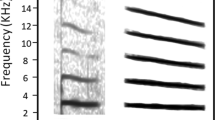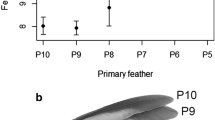Abstract
Crickets can autotomize a limb in order to evade predation; however, this autotomy compromises their escape speed and, therefore, their ability to avoid subsequent predation events. We recorded two measures of predator-avoidance behaviour in field crickets (Gryllus bimaculatus) exposed to varying levels of predation threat, with the most extreme level leading to autotomy of a limb. Our first measure of caution was time to emergence from cover, which was affected by perceived predation treatment, with both autotomized males and females being significantly more cautious than intact individuals. For males (but not females), the presence of a calling conspecific encouraged earlier emergence. Our second measure of caution was alteration of male calling behaviour. Autotomized males remained silent for significantly longer time after disturbance than intact males, but there was no difference in call rate once they had resumed calling, suggesting that behavioural changes were not merely a result of injury response but a controlled modification of behaviour as a result of autotomy. These data suggest that autotomy in field crickets results in altered calling behaviour, which was not significantly altered with different acoustic environments.





Similar content being viewed by others
References
Allen GR (1995) The biology of the phonotactic parasitoid, Homotrixa sp. (Diptera: Tachinidae), and its impact on the survival of male Sciarasaga quadrata (Orthoptera: Tettigoniidae) in the field. Ecol Entomol 20:103–110
Arnold E (1988) Caudal autotomy as a defence. In: Gans C, Huey R (eds) Biology of the reptilian, vol 13. Alan R. Liss, New York, pp 235–273
Bailey WJ, Haythornthwaite S (1998) Risks of calling by the field cricket Teleogryllus oceanicus; potential predation by Australian long-eared bats. J Zool (London) 244:503–513
Bateman PW (2001) Changes in phonotactic behaviour of a bushcricket with mating history. J Insect Behav 14:333–343
Bateman PW, Fleming PA (2005) Direct and indirect costs of limb autotomy in field crickets Gryllus bimaculatus. Anim Behav 69:151–159
Bateman PW, Fleming PA (in press) Increased susceptibility to predation for autotomized house crickets (Acheta domestica). Ethology
Belwood JJ, Morris GK (1987) Bat predation and its influence on calling behavior in neotropical katydids. Science 238:64–67
Cade WH (1975) Acoustically orienting parasitoids: fly phonotaxis to cricket song. Science 190:1312–1313
Cooper WE, Pérez-Mellado V, Vitt LJ (2004) Ease and effectiveness of costly autotomy vary with predation intensity among lizard populations. J Zool (London) 262:243–255
Crowley P, Travers S, Linton M, Cohn S, Sih A, Sargent R (1991) Mate density, predation risk, and the seasonal sequence of mate choice: a dynamic game. Am Nat 137:567–596
Dill L, Fraser A (1997) The worm re-turns: hiding behaviour a tube-dwelling marine polychaete, Serpula vermicularis. Behav Ecol 8:186–193
Dixon K (1989) Effect of leg type and sex on autotomy in the Texas bush katydid, Scudderia texensis. Can J Zool 67:1607–1609
Gras H, Hörner M (1992) Wind-evoked escape running of the cricket, Gryllus bimaculatus. I. Behavioural analysis. J Exp Biol 171:189–214
Gyssels FGM, Stoks R (2005) Threat-sensitive responses to predator attacks in a damselfly. Ethology 111:411–423
Hack MA (1997) The energetic costs of fighting in the house cricket, Acheta domesticus L. Behav Ecol 8:28–36
Hedrick AV (2000) Crickets with extravagant mating songs compensate for predation risk with extra caution. Proc R Soc Lond B Biol Sci 267:671–675
Hedrick AV, Dill LM (1993) Mate choice by female crickets is influenced by predation risk. Anim Behav 46:193–196
Hissman K (1990) Strategies of mate finding in the European field cricket (Gryllus campestris) at different population densities: a field study. Ecol Entomol 15:281–291
Hunt J, Brooks R, Jennions MD, Smith MJ, Bentsen CL, Bussiere LF (2004) High-quality male field crickets invest heavily in sexual display but die young. Nature 432:1024–1027
Jennions MD, Backwell PRY (1992) Chorus size influences on the anti-predator response of a neotropical frog. Anim Behav 44:990–992
Juanes F, Smith L (1995) The ecological consequences of limb damage and loss in decapod crustaceans: a review and prospectus. J Exp Mar Biol Ecol 193:197–223
Koivula K, Rytkonen S, Orell M (1995) Hunger-dependency of hiding behaviour after a predator attack in dominant and subordinate willow tits. Ardea 83:397–404
Lehmann G, Heller K-G (1998) Bushcricket song structure and predation by the acoustically-orienting parasitoid fly Therobia leonidei (Diptera: Tachinidae: Ormiini). Behav Ecol Sociobiol 43:239–245
Lewkiewicz DA, Zuk M (2004) Latency to resume calling after disturbance in the field cricket, Teleogryllus oceanicus, corresponds to population-level differences in parasitism risk. Behav Ecol Sociobiol 55:569–573
Lickman K, Murray A-M, Cade WH (1998) Effect of mating on female phonotactic response in Gryllus integer (Orthoptera: Gryllidae). Can J Zool 76:1263–1268
Lindsay SM, Woodin SA (1992) The effect of palp loss on feeding behavior of two spionid polychaetes: changes in exposure. Biol Bull 183:440–447
Martín J, López P (1999) When to come out from a refuge: risk-sensitive and state-dependent decisions in an alpine lizard. Behav Ecol 10:487–492
Martín J, López P (2000) Repeated predatory attacks and multiple decisions to come out from a refuge in an alpine lizard. Behav Ecol 12:386–389
Martín J, López P (2005) Wall lizards modulate refuge use through continuous assessment of predation risk level. Ethology 111:207–219
Miller LA, Surlykke A (2001) How some insects detect and avoid being eaten by bats: tactics and countertactics of prey and predator. Biosci Biotechnol Biochem 51:570–581
Pratt AE, McLain DK, Berry AS (2005) Variation in the boldness of courting sand fiddler crabs (Uca pugilator). Ethology 111:63–76
Robinson JV, Hayworth DA, Harvey MB (1991a) The effect of caudal lamellae loss on swimming speed of the damselfly Argia moesta (Hagen) (Odonata, Coenagrionidae). Am Midl Nat 125:240–244
Robinson JV, Shaffer LR, Hagemeier DD, Smatresk NJ (1991b) The ecological role of lamellae loss in the larval damselfly, Ischnura posita (Hagen) (Odonata: Zygoptera). Oecologia 87:1–7
Sih A (1986) Antipredator responses and the perception of danger by mosquito larvae. Ecology 67:434–441
Sih A, Krupa J, Travers S (1990) An experimental study on the effects of predation risk and feeding regime on the mating behavior of the water strider, Gerris remigis. Am Nat 135:284–290
Stoks R (1998) Effects of lamellae autotomy on survival and foraging success of the damselfly Lestes sponsa (Odonata: Lestidae). Oecologia 117:443–448
Stoks R (1999) Autotomy shapes the trade-off between seeking cover and foraging in larval damselflies. Behav Ecol Sociobiol 47:70–75
Stoks R, De Block M, Van Gossum H, Valck F, Lauwers K, Verhagen R, Matthysen E, De Bruyn L (1999) Lethal and sublethal costs of autotomy and predator presence in damselfly larvae. Oecologia 120:87–91
Tuttle M, Ryan M (1982) Bat predation and sexual advertisement in a neotropical anuran. Am Nat 119:136–139
Zuk M, Kolluru GR (1998) Exploitation of sexual signals by predators and parasitoids. Q Rev Biol 73:415–443
Acknowledgements
We gratefully acknowledge financial support from the University of Pretoria. This study complies with laws and regulations of South Africa and the University of Pretoria. We thank M. Ferreira and J.W.H. Ferguson for their generous access to unpublished data and three anonymous reviewers for their comments.
Author information
Authors and Affiliations
Corresponding author
Additional information
Communicated by D. Gwynne
Rights and permissions
About this article
Cite this article
Bateman, P.W., Fleming, P.A. Sex, intimidation and severed limbs: the effect of simulated predator attack and limb autotomy on calling and emergence behaviour in the field cricket Gryllus bimaculatus . Behav Ecol Sociobiol 59, 674–681 (2006). https://doi.org/10.1007/s00265-005-0096-6
Received:
Revised:
Accepted:
Published:
Issue Date:
DOI: https://doi.org/10.1007/s00265-005-0096-6




